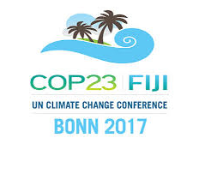
Written by Edvard Hviding and Camilla Borrevik.
Prior to the UNFCCC COP23 climate change conference held in Bonn, Germany in November 2017 (and hosted by Fiji as COP23 Presidency), new research from Australian ocean and climate scientists showed that in Solomon Islands, rates of sea level rise up to three times the global average, coupled with wind and wave action and additional environmental factors, had caused at least five small, low islands (between one and five hectares in size) to entirely disappear – while several other small islands with permanent human settlements had seen the loss of much of their inhabitable land areas as shorelines had eroded. This research became widely publicised and hotly debated in diverse media.
The locations of these documented instances of actual island loss to sea level rise were in the western parts of the Solomon Islands archipelago, an area very well known to OceanStates PI and Bergen Pacific Studies Director Edvard Hviding through his field research there since 1986. At COP23, the regional intergovernmental organisation Pacific Islands Development Forum organised a side event at the Fiji Pavilion to reflect on the “disappearing islands” of the Solomons and their significance as probable signs of things to happen more widely with the accelerating impacts of climate change across the Pacific. Hviding was invited to speak on this panel based on his long experience from this “hot spot” of island loss, but as Bergen Pacific Studies then PhD candidate Camilla Borrevik was heading to Bonn anyway as a member of Palau’s delegation, she and Hviding wrote the following text together, and Borrevik presented it at the “Disappearing Islands” panel on 7 November 2017. Certain observations and arguments in this COP23 presentation are central to the research agenda of the OceanStates project, and we therefore post it here on our Blog.
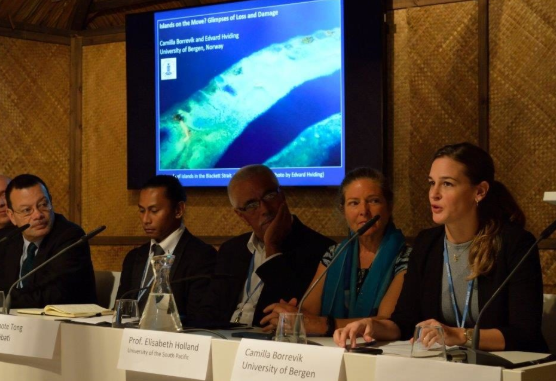
DISAPPEARING ISLANDS Side Event at COP23, 7 November 2017, Fiji Pavilion (Dr. Borrevik speaking) From left: Ronny Jumeau (UN ambassador of the Seychelles); Erbai Xavier Matsutaro (National Climate Change Coordinator, Palau); Anote Tong (Former President of Kiribati); Elisabeth Holland (Professor of Climate Change, University of the South Pacific); Camilla Borrevik (Bergen Pacific Studies, University of Bergen). Photo supplied by C. Borrevik.
Bula and good morning
I thank the Pacific Islands Development Forum for inviting me to speak at this event, at which I represent my own University of Bergen in Norway, while also being a member of the Palau Delegation. This presentation I give on behalf of myself and my colleague Professor Edvard Hviding in our Bergen Pacific Studies research group. In this I also pass on greetings from Professor Hviding who is not able to be here today, although he would have wanted to speak as well for Solomon Islands, which is his second country of belonging.
It is to honour Solomon Islands that we present our opening image: The sheer power and grace of the ocean, reef and small islands in the beautiful, but not always as calm, Blackett Strait – a deep channel that lies between the islands of Kolobangara and Kohinggo in the New Georgia group of the western Solomons.
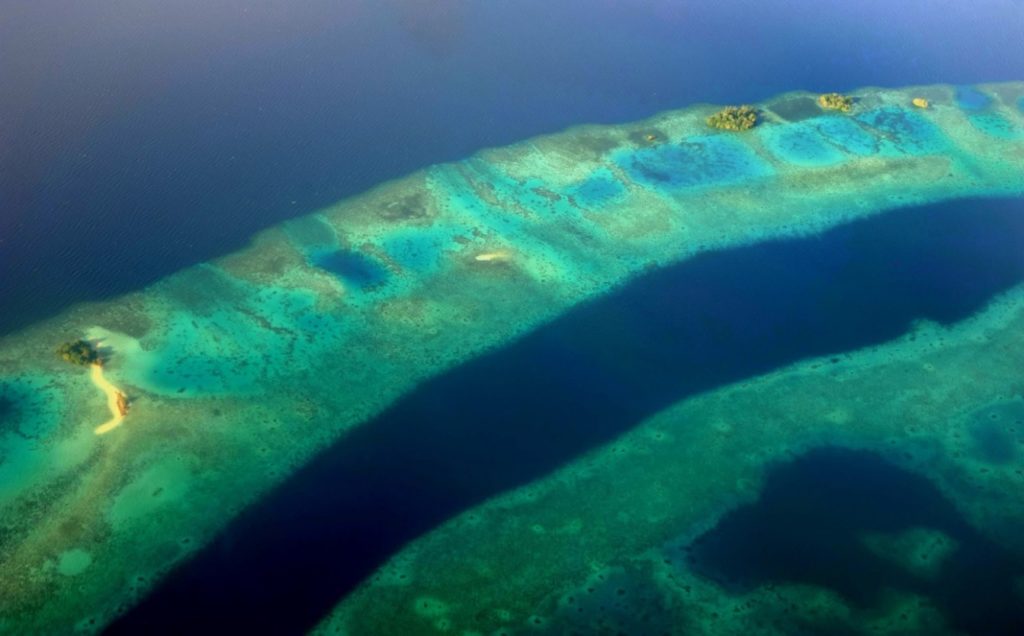
Photo by Edvard Hviding.
In Bergen, we are a group of social anthropologists who carry out research on the human dimensions of climate change in a number of places across the Pacific, and mainly in Solomon Islands, Palau and Fiji. As Norwegians, we also share with the people of Oceania a close relationship with the ocean. For us too, climate and ocean are inseparable. But Oceania is ahead of us in this maritime wisdom, and I recall here today the wise words of Oceania’s own great philosopher, the late professor Epeli Hau’ofa: WE ARE THE OCEAN.

The ocean is indeed fundamental to the historical and contemporary development of local and regional cultures, identities and ways of life in the Pacific Islands. However, in the 21st century, Pacific views of the great ocean as generative and supportive of regionally specific ways of human existence are challenged as the tables are turned: for the islanders of Oceania at large, oncoming effects of global climate change are to varying degrees transforming the life-giving ocean into a threat. As the warming, acidification and rising of the sea erode coral reefs and coastal zones throughout Oceania, and as new patterns of extreme weather become regular, low-lying islands across the region are destined for an unprecedented situation of permanent, part or total flooding.

Keru village, North New Georgia. Photo by Edvard Hviding
Villages on shores maybe no more than a metre above the high-water mark are already being washed away as storms of increasing force bring on unprecedented tidal floods. We have learnt about this not only through the media, but also through Oceania’s own great climate change warrior, Marshall Islands Minister Tony DeBrum, who not long ago left us much too soon. Another, particular news item about the loss of entire islands reached the global press media in May this year Long-term scientific study in the Western, Isabel and Choiseul provinces of Solomon Islands documented in detail how five smaller reef islands with vegetation have disappeared from sea-level rise and wave action, while several others have experienced large-scale recession of shorelines and flooding of much of their land.1 When this news broke, Simon Albert, the lead scientist of the research on these disappeared islands of the Solomons, pointed out that this loss of islands could be due to many factors not all of which were well understood. But, he said to The Guardian 0n 10 May 2017:
…the drowning of these lands is a window into the future. For the first time, we can see clearly that the amount of sea-level rise we expect from climate change will overwhelm entire landscapes. The key aspect I stand by is that these observations from the Solomons are a warning of things to come irrespective of if climate change alone caused it or a range of factors.
Albert concluded,
This is the first scientific evidence that confirms the numerous anecdotal accounts from across the Pacific of the dramatic impacts of climate change on coastlines and people.
To show more closely what this form of land loss means, we take you back again to the Blackett Strait of the Western Solomons, to another angle of the beautiful view of reefs and small islands we saw in the opening slide. This, however, is a somewhat darker afternoon with rain approaching. Please look closely at this image.
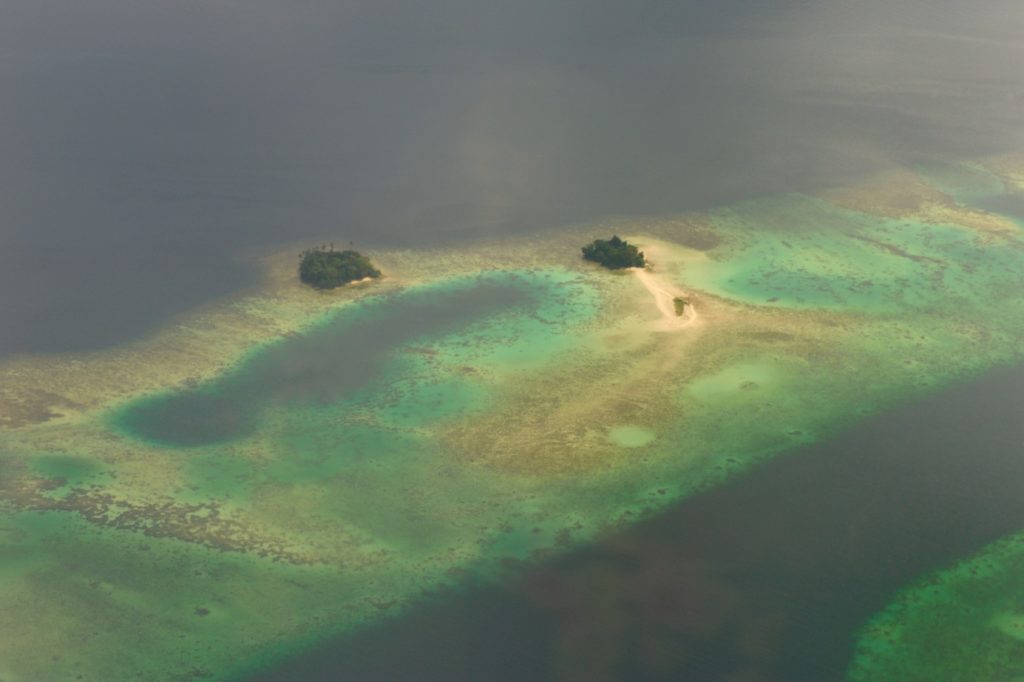
Photo by Edvard Hviding
What we see are three reef islands on the reef, all of which not long ago were of approximately equal size, about 1,5 hectares each. They all bore the typical kind of enduring forest of such islands: saltwater resistant trees and shrubs, a few coconut trees, and some mangroves at the edge. On the official 1:150,000 map of 1982 based on aerial photography from the 1970s, all three islands are of equal size.
Look at them now, on this image from 2012. The one at upper left (to the west) appears resilient; the one at upper right (to the east) seems somewhat battered. But just across the sand we see that that the third island, known to have been forested and stable thirty years ago, is no longer there. That third island has almost disappeared, its former existence now shown just by some low creeping plants in the sand. We can actually still glimpse its former, now ghostlike outline, made by vegetation debris mixed in with the sand.

The islanders of Kohinggo and Kolobangara have used and benefited from the many small forested reef islands in the Blackett Strait for centuries, as shelters for seafarers caught in a squall, as resting places for tired fishermen, and as a source of pigeons, crabs and turtles. They have names for all these islands, and over the generations they have followed the emergence, growth and movement of many of them. Their knowledge of these processes is empirical, fact-based, accumulated over the long term – and far from “anecdotal”. What the islanders said to Edvard Hviding in 2012 was that sea levels were now rising fast, and that the south-east trade winds – whose wave action has no doubt contributed to the demise of “island no. 3” – had become stronger and begun to blow incessantly for longer periods. Rising sea levels and stronger winds – and such islands disappear. This process is well known by Pacific Islanders. It is indeed that “window into the future” mentioned with reference to the scientific study of disappeared islands. This is loss and damage, and the future is there today, on those reefs where islands disappear.

Some outlying low islands of modest size and low elevation can have significance beyond what their smallness and remoteness would indicate. They may in fact be the markers of baselines from which the extent of the 200-mile zones of island nations are measured. And so with this form of loss and damage of small exposed reef islands being added to the repertoire of ravages from sea level rise and extreme weather, some islands of this sort may in fact be what make a small island nation into a Big Ocean State. When they disappear, the Exclusive Economic Zone is threatened. And so when small islands move into oblivion, a situation of larger scale may emerge where, to quote a key comment made by Tuvalu’s Prime Minister Sopoanga at the Ocean Conference in New York in June, “EEZ baselines may start to move too”. That is loss and damage of the highest and most urgent order. The disappearance of small islands in the Solomons is indeed a warning of things to come.
1. Albert, S., J.X. Leon, A.R. Grinham, J. Church, B.R. Gibbes & C.D. Woodroffe 2016. Interactions between sea-level rise and wave exposure on reef island dynamics in the Solomon Islands. Res. Lett. 11: 054011. http://dx.doi.org/10.1088/1748-9326/11/5/054011.

DISAPPEARING ISLANDS Side Event, COP23, 7 November 2017. Full panel. Photo supplied by C. Borrevik
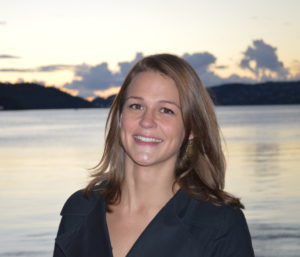
Camilla Borrevik
Dr. Camilla Borrevik is a member of the Bergen Pacific Studies research group. She holds a PhD in Social Anthropology from the University of Bergen, where she has been working as a science diplomacy advisor. Dr. Borrevik’s research focuses on climate change, diplomacy, policy, knowledges and Pacific regionalism.

Edvard Hviding. Photo credit: Eivind Senneset
Professor Edvard Hviding is the project director for the OceanStates project. He is a Professor of Social Anthropology at the Department of Social Anthropology at the University of Bergen and director of the Bergen Pacific Studies (BPS) research group